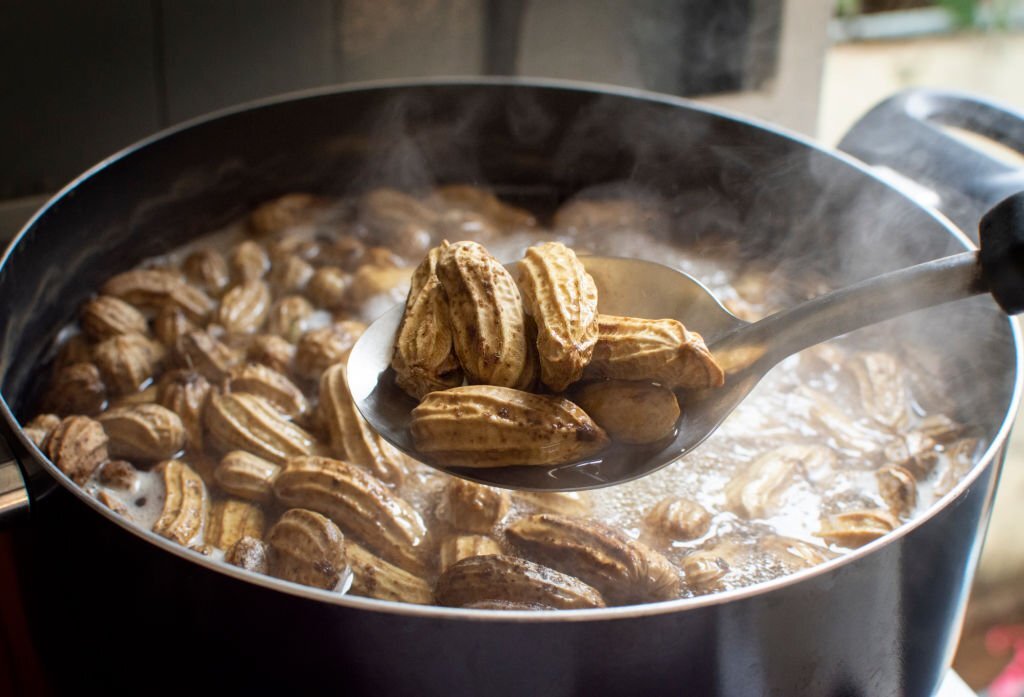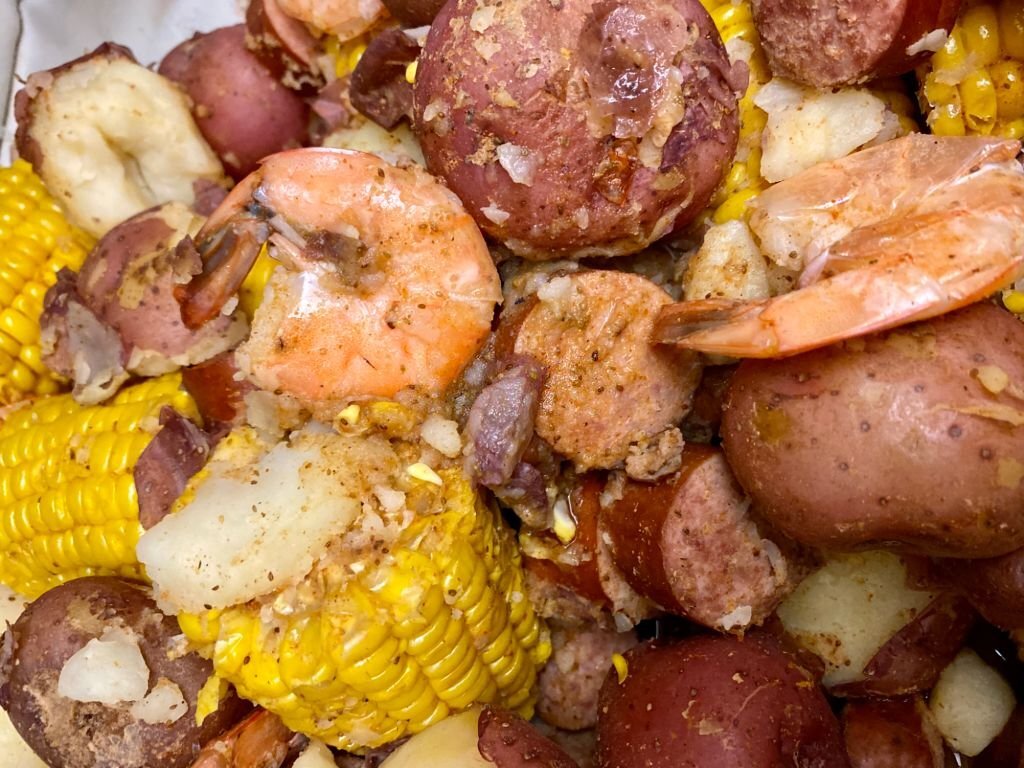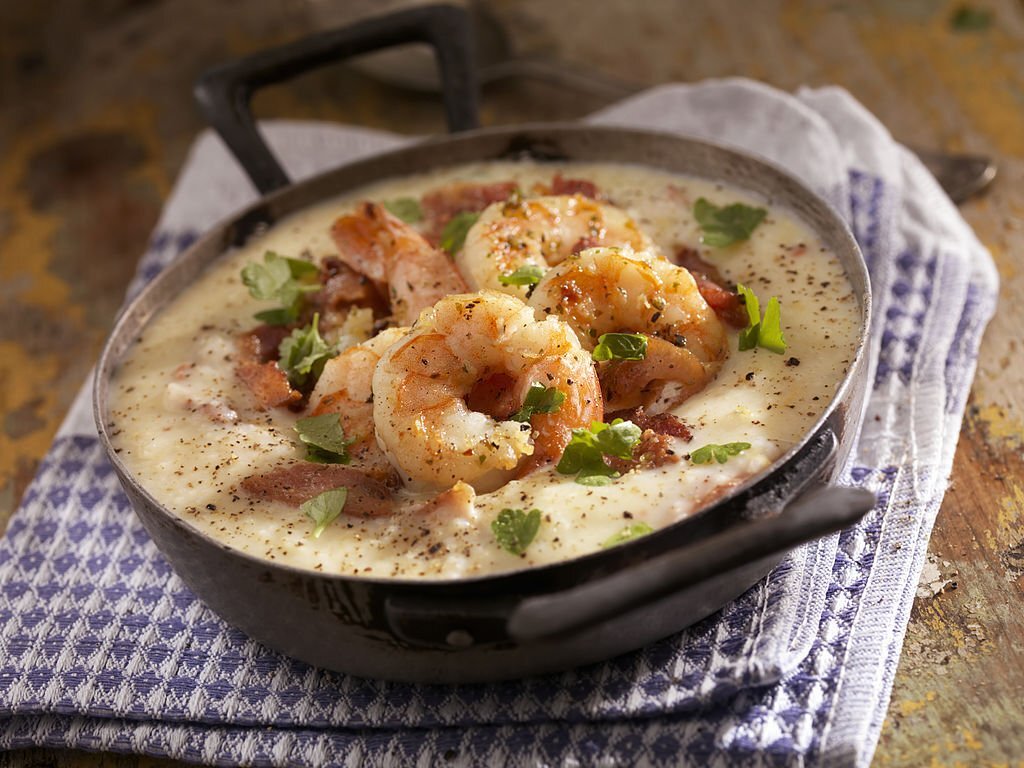Welcome to the culinary world of South Carolina—a place where tradition and innovation walk hand in hand, offering a gastronomic experience that’s as diverse as it is delicious.
 Whether you’re a lifelong resident or a curious traveler, this state has a smorgasbord of iconic foods that speak volumes about its rich history, cultural diversity, and regional influences.
Whether you’re a lifelong resident or a curious traveler, this state has a smorgasbord of iconic foods that speak volumes about its rich history, cultural diversity, and regional influences.
You’ll find that South Carolina’s food scene is like a patchwork quilt, each piece representing a unique blend of flavors, ingredients, and cooking methods.
From the coastal delights of shrimp and grits to the smoky flavors of authentic barbeque, and from the versatility of okra to the iconic status of Sweet Tea, this guide will take you on a journey through the state’s most famous foods. Get ready to whet your appetite and feed your soul!
Contents
Boiled Peanuts
 Boiled peanuts are much more than a casual snack; they’re an edible piece of history. Originating from the culinary traditions of Africa, this humble legume made its way to the Southern United States through the African slave trade.
Boiled peanuts are much more than a casual snack; they’re an edible piece of history. Originating from the culinary traditions of Africa, this humble legume made its way to the Southern United States through the African slave trade.
It served as a nutrient-rich food source initially and later became a beloved snack for Civil War soldiers. Fast forward to today, boiled peanuts have evolved into a cultural icon, representing Southern hospitality and traditions.
So how does a raw peanut transform into this celebrated snack? Raw peanuts are submerged in a pot of water saturated with salt. They are then slow-cooked for several hours until they reach a soft, almost bean-like texture. This isn’t just cooking; it’s an exercise in patience and precision.
“The result? A flavor profile that is both complex and comfortingly simple. With a taste that falls somewhere between a chickpea and a roasted peanut, boiled peanuts have an earthiness that’s balanced by the salty brine, making each bite an umami explosion. If you’re passionate about exploring diverse culinary experiences, you’ll also want to indulge in the delightful world of French culinary delights.”
Boiled peanuts are a roadside attraction in South Carolina. Imagine this: you’re driving through the picturesque landscapes of the state, and you see a makeshift stand with a sign that reads “Fresh Boiled Peanuts.” It’s an invitation to take a break, have a chat with locals, and enjoy a handful of warm, salty goodness.
Carolina Reaper
The Carolina Reaper is not just any pepper; it’s the embodiment of culinary audacity. Developed by Ed Currie in South Carolina, this pepper came into existence through a careful crossbreeding process involving a Pakistani Naga pepper and a Red Habanero.
If you’re intrigued by iconic creations in other fields, you might also be interested in the oakland music heritage, a rich tapestry of sounds and styles that has made its own mark on American culture.
This small, wrinkled red fruit holds the Guinness World Record for the world’s hottest pepper, with heat levels that exceed 1.5 million Scoville Heat Units. It’s the fire-breathing dragon of the food world.
How do you make use of a pepper that’s almost weapon-grade hot? With extreme care! The Carolina Reaper is usually found in hot sauces, spicy challenge dishes, and artisanal spice mixes.
A tiny sliver can turn a regular dish into an adventurous eating experience. However, be warned: this pepper requires handling with gloves, and consuming it is not advised for those with a low tolerance for spice.
Chicken Bog
“Chicken Bog is a culinary tradition deeply rooted in the act of communal eating, emphasizing Pensacola’s identity as a hub for diverse flavors and cultural influences. Originating from the vibrant culinary landscape of South Carolina’s Lowcountry, this delightful dish combines tender chicken, fragrant rice, and a medley of aromatic spices, all expertly simmered in a single, generously-sized pot.
The term ‘bog’ aptly characterizes its texture—somewhat mushy yet undeniably comforting. To truly understand the heart and soul of Pensacola’s culinary scene, delve into the significance of this communal feast by exploring ‘Exploring Pensacola’s Identity’ at Tales of Travelers.”
Preparing Chicken Bog is akin to composing a symphony where each ingredient plays a critical role. The chicken is often slow-cooked until it falls off the bone, allowing its flavors to permeate the rice. The spices add complexity, while the rice absorbs every last bit of flavor, leading to a dish that is much greater than the sum of its parts.
Chicken Bog isn’t just food; it’s an event. Traditionally served at community gatherings, family reunions, and local festivals, it symbolizes unity and shared heritage. A single pot can serve a large crowd, making it the ultimate comfort food for community bonding.
Frogmore Stew/Lowcountry Boil Frogmore
 Frogmore Stew, also known as Lowcountry Boil, is a seafood lover’s dream. Despite its name, it’s not a stew at all but rather a hearty, one-pot boil loaded with shrimp, crab, potatoes, corn, and sausage. It’s said to have originated in Frogmore, a community on St. Helena Island in South Carolina. But don’t worry; no frogs are involved in the making!
Frogmore Stew, also known as Lowcountry Boil, is a seafood lover’s dream. Despite its name, it’s not a stew at all but rather a hearty, one-pot boil loaded with shrimp, crab, potatoes, corn, and sausage. It’s said to have originated in Frogmore, a community on St. Helena Island in South Carolina. But don’t worry; no frogs are involved in the making!
Imagine a large pot, preferably outdoors over an open flame. The cooking starts with the layering of flavors, beginning with a boiling pot of well-seasoned water. Potatoes go in first, followed by corn, sausage, and finally, the seafood. It’s about timing and sequence.
When done right, you get a pot full of goodness where each ingredient has absorbed the spices, imparting a distinctive, unified flavor.
The real beauty of Frogmore Stew lies in its communal aspect. It’s often prepared outdoors, and when it’s ready, the contents are usually dumped onto a newspaper-covered table. People gather around to eat with their hands, making it not just a meal but a social event that embodies the spirit of South Carolina.
Okra
Okra holds a special place in South Carolina cuisine. Introduced to the American South from Africa, okra has been a staple ingredient for centuries. Its texture and flavor make it versatile, ideal for a variety of preparations, from frying to stewing.
What’s the magic of okra? Is it the unique, somewhat slippery texture when cooked? Or is it the subtle, grassy flavor? Whether fried, stewed, or even pickled, okra is like the Swiss army knife of vegetables. It can thicken a gumbo, add crunch to a salad, or stand alone as a simple, salted side dish.
Peaches
Move over, Georgia; South Carolina is a significant player in the peach game too! In fact, South Carolina ranks second in U.S. peach production. Known for its incredibly juicy and sweet peaches, the state has turned this fruit into an almost iconic symbol of summer.
While peach pie and peach cobbler are classics, South Carolina’s peaches have a range that extends beyond dessert. Think peach salsa, peach-glazed meats, or even a refreshing peach Bellini. The fruit’s natural sweetness and tanginess make it incredibly versatile, allowing it to shine in both sweet and savory dishes.
Peaches hold a special place in South Carolina’s heart, transcending their status as merely a crop to become a cherished cultural phenomenon. As summer arrives, the state comes alive with vibrant peach festivals and bustling farmers’ markets, all celebrating this succulent fruit’s unique charm.
From offering fresh, juicy slices to exquisite homemade preserves and more, these gatherings embody what South Carolina is known for. Speaking of distinctive qualities, you might also find yourself intrigued by Oklahoma’s unique charm, which you can explore further on the page titled Oklahoma’s unique charm.
Shrimp and Grits
Shrimp and grits is the epitome of coastal Southern comfort food. With roots deeply embedded in the Lowcountry cuisine of South Carolina, this dish celebrates both the bounty of the sea and the produce of the land. The marriage of shrimp from the coast with grits made from locally-sourced corn creates a gastronomic match made in heaven.
At its core, shrimp and grits is a simple dish. Creamy, buttery grits serve as the base, providing a comforting backdrop to the shrimp.
The shrimp are often sautéed with ingredients like garlic, onions, and bell peppers. Some variations include a rich gravy, made by incorporating ingredients like bacon, butter, and sometimes a splash of white wine or broth.
While the traditional shrimp and grits is divine in its simplicity, chefs across South Carolina have taken creative liberties with the dish. You’ll find variations featuring Andouille sausage, poblano peppers, or even an accompaniment of fried green tomatoes. Each rendition reflects the diversity of South Carolina’s culinary scene.
What Are Grits
 If you’re not from the South, you might be wondering, “What exactly are grits?” Simply put, grits are a dish made from dried, ground corn, typically the hominy variety. They serve as the Southern answer to Northern oatmeal, albeit with a different texture and flavor profile.
If you’re not from the South, you might be wondering, “What exactly are grits?” Simply put, grits are a dish made from dried, ground corn, typically the hominy variety. They serve as the Southern answer to Northern oatmeal, albeit with a different texture and flavor profile.
Preparing grits is a straightforward but exacting process. The coarsely ground cornmeal is boiled in water or milk until it softens and absorbs the liquid.
The result is a creamy, versatile dish that can be tailored to suit both savory and sweet tastes. Think of grits as a blank canvas, ready to absorb whatever flavors you throw at it—from sharp cheddar and shrimp to butter and sugar.
Grits share a lot of similarities with polenta, an Italian dish also made from cornmeal. However, the corn used for grits is usually treated with an alkali, turning it into hominy before grinding, which gives it a unique flavor and texture.
If you’re interested in exploring more about the culinary traditions that vary across the United States, you might want to check out Beemerville’s fiery past revealed on the Tales of Travelers website, which delves into the distinctive food history of different regions, including New Jersey.
While polenta is often served as a side dish or used as an ingredient in other dishes, grits stand as a cultural cornerstone, especially in South Carolina.
South Carolina Barbeque
When it comes to barbeque, South Carolina holds a special place in the smoky pantheon of American pitmasters. The state’s barbeque history can be traced back to early Native American and colonial cooking techniques, where meat was smoked over an open flame. But South Carolina isn’t just one of the original BBQ states; it’s also the birthplace of BBQ sauce as we know it.
What makes South Carolina barbeque unique? It’s all about the sauce. The state is renowned for its four primary types of BBQ sauce: mustard-based, vinegar and pepper, light tomato, and heavy tomato.
Each sauce speaks to different regional influences, from German settlers’ mustard sauce to the vinegar-based recipes of the eastern coastal plain.
In South Carolina, barbeque is more than a dish; it’s an event, an occasion for community gatherings, be it a family reunion, a church event, or a local festival.
You’ll often find pitmasters laboring over their grills and smokers, aiming for that perfect balance of smoke, spice, and sauce. The end result is a plate full of succulent, flavorful meat that’s best enjoyed in good company.
Sweet Tea
 Sweet Tea isn’t just a drink in South Carolina; it’s a cultural statement. This deceptively simple beverage, made from tea leaves, sugar, and good ol’ Southern tap water, transcends its humble origins to represent the very essence of Southern hospitality.
Sweet Tea isn’t just a drink in South Carolina; it’s a cultural statement. This deceptively simple beverage, made from tea leaves, sugar, and good ol’ Southern tap water, transcends its humble origins to represent the very essence of Southern hospitality.
Making Sweet Tea is not merely a task; it’s a rite of passage. The process usually involves boiling water, steeping black tea leaves, and then adding sugar while the tea is still hot.
This ensures that the sugar completely dissolves, creating a perfectly balanced, syrupy sweetness. Once prepared, it’s often poured over a generous amount of ice and garnished with a slice of lemon, showcasing the exquisite artistry of Tourism in Oklahoma. Ah, perfection in a glass! For more delightful travel experiences, explore what Oklahoma is known for.
Sweet Tea plays a role that’s not dissimilar to the English cuppa—it’s an excuse for socialization. Whether at a family dinner, a church gathering, or a casual meet-up, Sweet Tea is often the drink of choice, providing that liquid comfort that seems to make conversations flow a bit more freely.
Conclusion
As we wrap up this culinary voyage through the foods that make South Carolina famous, it’s clear that the state’s gastronomy is a reflection of its complex history and diverse cultural influences. The ingredients may be simple, but the flavors are intricate, layered, and deeply rooted in tradition.
Whether it’s the communal experience of Frogmore Stew or the simple comfort of a cold glass of Sweet Tea, these dishes and drinks do more than satiate hunger—they tell the story of a community, a history, and a way of life.
If you haven’t yet indulged in the unique flavors of South Carolina, you’re in for a treat that extends far beyond the palate. Food here isn’t just sustenance; it’s an experience, a tradition, and a conversation starter. So go ahead, pull up a chair, pour yourself some Sweet Tea, and dive into the rich culinary landscape that defines this extraordinary state.

